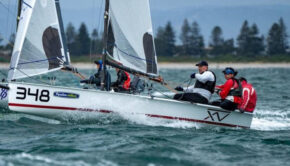Settling protests on the water
Published on September 4th, 2014
At a fleet racing national championship, the stakes are set high, and there is a high chance that a protest flag will fly. Most of the time, competitors will find themselves in front of the protest committee explaining their side of the story, and the judges have to make a decision based on the sailors’’ testimonies.
However, the 2014 49er, 49er FX, and NACRA 17 U.S. National Championship (August 22-24) hosted by Oakcliff Sailing experimented with a different approach: umpired fleet racing for the medal race. With no more than 10 boats in the medal race, the three umpire boats are able to canvas the course to make calls immediately once a protest flag is raised on the water during a race.
“Umpired fleet racing is the preferred way of officiating,” said Bruce Cook, an International Umpire and Judge for the International Sailing Federation (ISAF). “The rules are taken care of on the water most of the time, so competitors do not have to think about going to a protest hearing after racing.”
Umpiring is regularly used during team and match racing due to their head-to-head nature, but umpired fleet racing has become a recent trend in high-level competition events.
.
“The umpires stand a better chance of seeing the major infractions clearly and making the right calls on the water, which allows the race to progress and the sailors know where they stand on the water,” said Dave Perry, a US Sailing Senior Certified Judge, accomplished sailor himself, and a rules expert.
There was one major umpire call during the medal race for the 49er that led to the determination of the 1st place finisher. Umpires Bruce Cook and Bill Simon had to call whether or not Fred Strammer and Zach Brown gybed too close to Brad Funk and Trevor Moore. Funk and Moore needed to have Strammer and Brown receive a penalty, so they would have a better chance at the win. Click here to see the footage of the situation. (It occurs around 5:18)
While the Sailing Instructions limit the rules under which a penalty or protest can be initiated by the umpire, the active role of the umpire occurs when a protested boat does not take a penalty voluntarily. In this instance, the umpire can rule:
– No penalty: When either no penalty occurs or the umpire could not see it occur.
– Penalty: The protested boat must take a One-Turn Penalty
– Disqualified: The protested boat must leave the course area.
Umpired fleet racing is still in the experimental stage of its development, so it was not a surprise when umpires Bruce Cook, Dave Perry, and Bill Simon recognized technical problems at the US Championship.
“With match racing, the relationship between boats is clearly visible, because you are focusing on only one or two boats,” said Bill Simon, a judge and the Race Program Director at Oakcliff Sailing. “With team racing, it is fairly clear since there may only be a few boats. The relationship with boats during fleet racing is unclear, because there are so many on the course. It is hard to place yourself in the perfect position to make the call.”
Another issue is deciding which umpire should make a call. According to Simon, this was most common at the leeward gate where the umpires from each side of the course would meet due to the fleet condensing.
Source: Samantha Pilz, Oakcliff Sailing









 We’ll keep your information safe.
We’ll keep your information safe.